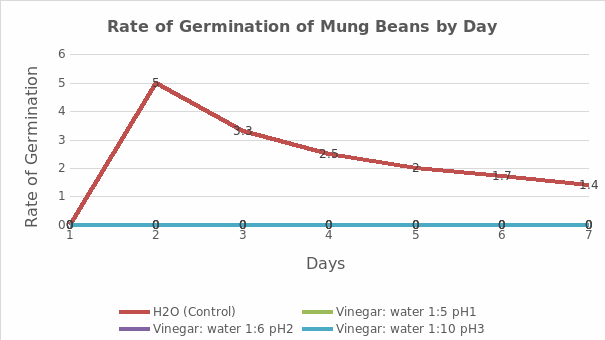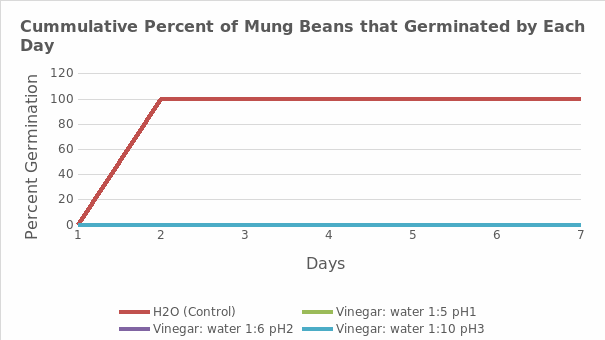Abstract
Since pH influences seed germination, the purpose of the study was to determine the effects of vinegar on the germination rate of mung bean seeds over a period of one week. The study hypothesized that vinegar reduces the pH of water and inhibits the germination of mung beans. To achieve valid findings, the study involved an experimental methodology whereby four groups of mung beans, made of 10 seeds each, were soaked in deionized water, 1:2 vinegar to water (pH 1), 1: 6 vinegar to water (pH 2), and 1:10 vinegar to water (pH 3).
The number of the seeds that germinated was counted each day for a period of one week. The findings indicated that the proportion of mung beans soaked in water that germinated was 100% on the second day and germination rate was five on the same day. In comparison, the percent germination of mung beans soaked in acidified water was zero and the germination rate was zero because none of the seeds germinated during the period of the experiment. In conclusion, the findings supported the hypothesis that vinegar inhibits germination of mung beans.
Introduction
Seed germination is a complex process, which is under the control of many environmental conditions such as temperature, moisture content, oxygen concentration, salinity, and pH, among other factors. The germination process is complex because the seeds break their dormancy and sprout into seedlings by utilizing stored nutrients under favorable environmental conditions. Usually, optimal environmental conditions increase the rate of seed germination.
In this view, pH is a considerable factor that affects the germination of a seed because it disrupts physiological processes that are integral in the germination process (Zhang 1621). The concentrations of H+ and OH– in water determine the level of pH in a given environment. A higher concentration of OH– than H+ causes the pH to be basic, which means the level of pH is between eight and fourteen. In contrast, a lower concentration of OH– than H+ reflects the acidic state, which implies that the level of pH is between one and six. In a natural environment, the pH is about seven, which is a neutral level where the concentration of OH– and H+ are equal.
Fundamentally, the rate of germination varies according to the type of seed and the level of pH in a given environment. Some seeds germinate best in acidic conditions, whereas others germinate in basic conditions. Extreme conditions of pH have inhibitory effects on the germination process of seeds. Low pH inhibits the germination of seeds because water molecules exist in an ionized state of H+, which makes them unavailable for the germination process (Malik 28).
Owing to the reduced osmotic potential of seeds, their germination rate reduces significantly or halts completely. Since the germination process is under the control of enzymatic reactions, low pH denatures enzymes and inhibits them from carrying out biochemical reactions. A study, which was conducted to determine the optimum pH for the germination of Trifolium pretense seeds, revealed that optimal germination rate was achieved at pH values of between four and six, while pH values lower than 4, but greater than 7 inhibited the germination of the seeds (Agic et al. 77).
Hence, the germination rate of seeds is subject to the pH conditions of the environment. In this case, the objective of the study is to determine the effects of vinegar on the germination rate of mung bean seeds over a period of 7 days. The study hypothesizes that low pH due to vinegar significantly inhibits the germination of mung beans.
Method and Materials
The materials that were used in the experiment to determine the effect of vinegar on the germination rate of mung beans were 40 seeds of mung beans, 8 paper towels, 4 Ziploc plastic bags, and 10ml of deionized water (control group). Various solutions of vinegar, namely, 1:2 vinegar to water (pH 1) for the first trial (experimental group), 1: 6 vinegar to water (pH 2) for the second trial (experimental group), and 1:10 vinegar to water (pH3) for the third trial (experimental group) were used in germinating mung beans.
In the methodology, the 40 mung beans were divided into four groups comprising of 10 seeds each. Each of the four groups of mung beans was placed into folded paper towels, which were made by folding two pairs of paper towels. The four folded paper towels containing mung beans were then placed in each of the four Ziploc plastic bags.
To commence the germination process, the paper towels containing mung beans in the Ziploc plastic bags were soaked separately using 10 ml of deionized water (control), 10 ml of 1:2 vinegar to water (pH 1), 10 ml of 1: 6 vinegar to water (pH 2), and 1:10 vinegar to water (pH3). The Ziploc plastic bags containing soaked mung beans were then placed on the windowsill and the numbers of seeds that germinated were counted daily at 4 pm for a period of one week. The rate of germination and the percent germination were calculated and the results were presented using a table and two graphs.
Results
The results of the study are presented below (table1 and figure 1 and 2). Table 1 presents the summary of the findings in terms of the cumulative percent of mung beans, which germinated in each day for a period of seven days. In each of the four samples of mung beans, what is common is that the seeds did not germinate on the first day. However, during the second day the difference emerged as all the mung beans soaked in deionized water germinated, while the ones soaked in acidified water (with vinegar) did not germinate. Moreover, in the subsequent days until the seventh day, none of the beans soaked in the acidified water germinated.
Table 1: Summary of Findings
The graph below (figure 1) displays a day-by-day rate of germination of mung beans for a period of seven days. What is evident from the table is that the rate of germination of mung beans soaked in deionized water (control) reached its peak by the second day (5 seeds per day) and subsequently decreased during the next 5 five days. Since no mung seeds germinated under the acidic conditions of vinegar, the rate of germination was zero.

Figure 2 below displays the cumulative percent of mung beans that germinated for a period of seven days. The percent germination of mung beans soaked in deionized water reached 100% on the second day and remained that way for a week. Comparatively, the percent germination of mung beans soaked in water acidified with vinegar remained at zero because none of the seeds germinated.

Discussion
The findings presented in table 1 indicates the cumulative percent of the germination of mung seeds under various conditions of pH, namely, neutral pH (water), 1:2 vinegar to water (pH 1), 1: 6 vinegar to water (pH 2), and 1:10 vinegar to water (pH 3). All mung seeds soaked in deionized water germinated by the second day (100% germination rate). For seeds to germinate, they must absorb water, which activates biochemical processes that lead to the utilization of stored food.
According to Manz et al., the osmotic potential of seeds is high in water with a neutral pH and free from any dissolved substances that interfere with the process of osmosis (1540). Liu et al. add that the osmotic gradient between seeds and neutral water is very high because H+ and OH– are absent (4). In this case, all the mung beans soaked in deionized water germinated by the second day because nothing interfered with the process of osmosis.
Figure 2 indicates that the percent germination reached 100% on the second day and remained constant for the next five days. The rate of germination of mung beans was high during the second day because all the seeds germinated. Figure 1 shows that the rate of germination was 5 seeds per day.
Comparatively, mung beans soaked in water acidified with vinegar to pH levels of 1, 2, and 3 did not germinate. The rate of germination of each group of seeds soaked in acidified water with pH values of 1, 2, and 3 remained at zero, as shown in figure 1. Likewise, percent germination of the mung beans soaked in the acidified water was zero in pH values of 1, 2, and 3, as displayed in Figure 2. Since water with low pH has high concentrations of H+, they reduce the osmotic potential of seeds and prevent them from absorbing enough water, which is necessary for the germination process (Vacino-Bueno, Redondo-Gomez, and Figueroa 58).
Additionally, Agic et al. explain that low pH reduces the activity of α-amylase, an enzyme that is responsible for breaking down stored starch in the seeds (79). Hence, low pH has multiple effects on inhibiting the germination of mung beans in that it inhibits the absorption of water, which causes toxic metal ions to accumulate, deactivates α-amylase that catalyze the germination process, and causes deficiency of nutrients. In this case, the findings support the hypothesis that low pH conditions due to vinegar significantly inhibit the germination of mung beans.
Conclusion
Germination of seeds is under the influence of diverse environmental conditions such as temperature, salinity, oxygen concentration, and pH. In this case, the study revealed that vinegar affected the germination rate of mung beans over a period of seven days. The mung beans, which were soaked in deionized water, depicted the highest percent germination of 100% on the second day and the highest germination rate of five seeds.
Comparatively, the mung beans that were soaked in the water acidified with vinegar had a zero percent germination and a zero germination rate. These findings imply that low pH completely inhibits germination of mung beans. Conclusively, the findings of the study support the hypothesis that low pH conditions due to vinegar significantly inhibit the germination of mung beans.
Works Cited
Agic, Dejan, Gordana Bukvic, Sonja Grljusic, Drago Beslo, Janja Horvatic, and Dario Novoselovic. “Effect of pH on α-amylase activity and early seedling growth of red clover (Trifolium partense L.).” Notulae Botanicae Horti Agrobanici Cluj 37.2 (2009): 77-80. Print.
Liu, Yuan, Quanzhen Wang, Yunwei Zhang, Jian Cui, Guo Chen, Bao Xie, and Chunchiu Wu. “Sunergistic and antagonistic effects of salinity and pH on germination in switchgrass (Panicum virgatum L.).” PLOS ONE 9.1 (2014): 1-9. Print.
Malik, Raul, Gupta Manisha, Lokendra Singh, and Vishal Deshwal. “Studies of different pH levels of simulated acid rain on Lens culinaris CVS.” Journal of Botanical Sciences 2.3 (2013): 27-30. Print.
Manz, Bertram, Kerstin Muller, Birgit Kucera, Frank Volke, and Gerhard Leubner-Metzger. “Water uptake and distribution in germinating tobacco seeds investigated in vivo by nuclear magnetic resonance imaging.” Plant Physiology 138.1 (2005): 1538-1551. Print.
Vacino-Bueno, Inmaculada, Susana Redondo-Gomez, and Enrique Figueroa. “Effect of pH on germination of the endermic healther, Erica andevalensis.” Journal of Aquatic Plant Management 47.1 (2009): 57-59. Print.
Zhang, Hai-yan. “Effects of simulated acid rain on seed germination and seedling growth of different type corn (Zea mays).” Chinese Journal of Applied Ecology 24.6 (2013): 1621-1626. Print.